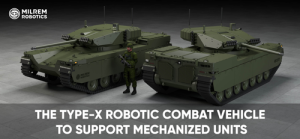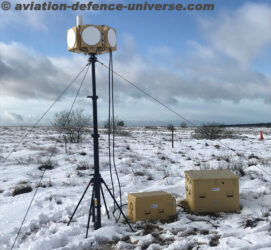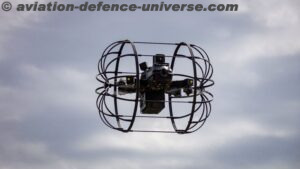
Tallinn, Estonia. 25 November 2021. The demonstration that was performed in September in Latvia, was led by LMT, a member of the integrated Modular Unmanned Ground System (iMUGS) consortium, with the support of the project coordinator Milrem Robotics and featured an ensemble of different technology.
Latvian National Armed Forces used two Milrem Robotics’ THeMIS Unmanned Ground Vehicles (UGV) during two scenarios to display the benefits of teaming up manned units with unmanned systems.
One THeMIS UGV was equipped with an Intelligence, surveillance, and reconnaissance (ISR) payload, Signal Intelligence antenna (SIGINT) provided by The Electronic Communications Office of Latvia, Rheinmetall’s Rapid Obscuring System (ROSY) Smoke Grenade Launcher, Bittium’s Vehicular Software Defined Radios (Tough SDR Vehicular), and FN Herstal’s deFNder Light Remote Weapon Station (RWS). The RWS integration was part of the demonstration, but not of the iMUGS project itself.
The second THeMIS, used as a mule for transporting the squad’s equipment, was equipped with Rantelon’s Improvised Explosive Device (IED) Jammer and Bittium’s Tough SDR Vehicular.
The units and UGVs used Bittium’s tactical communication network TAC WIN combined with LMT’s commercial 4G and a tactical 5G-SA bubble provided by Bittium and Cumucore.
In addition, Krauss-Maffei Wegmann’s (KMW) Dingo infantry mobility vehicle was used as the command centre from where UGVs were operated in Line of Sight (LOS) and Beyond the Line of Sight (BLOS) mode using Bittium’s SDR radios and to where the ISR and Signal Intelligence sensor feed was relayed and incorporated into LMT’s Battle Management System Viedsargs.
“The displayed scenarios showed that unmanned systems, enhanced with innovative communication systems and various defence technology, can be used for collecting and sharing tactical information, improve situational awareness, decrease troops physical load, and increase force protection,” explained Kuldar Väärsi, CEO of Milrem Robotics.
”For the first time ever, in a special network, a tactical network was connected with a stand-alone 5G network. This allowed communication between units and robots, as well as collecting information from sensors and placing this information into LMT’s Battle Management System “Viedsargs”,” said Ingmars Pukis, Vice President and Member of the Management Board of LMT.
Additional equipment used in the demonstration included: SRC Brasa’s NATRIX UGV used for CASEVAC, high-speed First-Person View drone, Vertical Take-off, and Landing UAV STAR, and a gunshot detection and source recognition audio sensor by Riga Technical University (RTU).
The iMUGS project was launched in 2020 to develop a modular, cyber secure and scalable architecture for hybrid manned-unmanned systems. Its goal is to standardize a Europe-wide ecosystem for ground platforms, command, control and communication equipment, sensors, payloads, and algorithms. Addressed operational challenges include enhanced interoperability, increased situational awareness and faster decision-making.
The system will use an existing UGV – Milrem Robotics’ THeMIS – and a specific list of payloads.
The project’s progress is displayed during six demonstrations. „So far Milrem Robotics and LMT Innovations have set the bar very high. Which means we have some great things to wait for as the main results of the iMUGS projects are yet to be seen,“ said Martin Jõesaar from the Estonian Center for Defence Investments, the representative of the participating Member States in the iMUGS Project. The next demonstration will take place in Q1 of 2022 in Finland.
iMUGS is a cooperation between 13 parties: Milrem Robotics (project coordinator), Bittium, Diehl Defence, dotOcean, GMV Aerospace and Defence, Insta Advance, Krauss-Maffei Wegmann, Latvijas Mobilais Telefons (LMT), NEXTER Systems, Royal Military Academy of Belgium, Safran Electronics & Defense, Sol.One and Talgen Cybersecurity.
























































































































